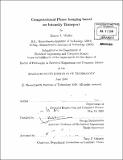Computational phase imaging based on intensity transport
Author(s)
Waller, Laura A. (Laura Ann)
DownloadFull printable version (20.18Mb)
Other Contributors
Massachusetts Institute of Technology. Dept. of Electrical Engineering and Computer Science.
Advisor
George Barbastathis.
Terms of use
Metadata
Show full item recordAbstract
Light is a wave, having both an amplitude and a phase. However, optical frequencies are too high to allow direct detection of phase; thus, our eyes and cameras see only real values - intensity. Phase carries important information about a wavefront and is often used for visualization of biological samples, density distributions and surface profiles. This thesis develops new methods for imaging phase and amplitude from multi-dimensional intensity measurements. Tomographic phase imaging of diffusion distributions is described for the application of water content measurement in an operating fuel cell. Only two projection angles are used to detect and localize large changes in membrane humidity. Next, several extensions of the Transport of Intensity technique are presented. Higher order axial derivatives are suggested as a method for correcting nonlinearity, thus improving range and accuracy. To deal with noisy images, complex Kalman filtering theory is proposed as a versatile tool for complex-field estimation. These two methods use many defocused images to recover phase and amplitude. The next technique presented is a single-shot quantitative phase imaging method which uses chromatic aberration as the contrast mechanism. Finally, a novel single-shot complex-field technique is presented in the context of a Volume Holographic Microscopy (VHM). All of these techniques are in the realm of computational imaging, whereby the imaging system and post-processing are designed in parallel.
Description
Thesis (Ph. D.)--Massachusetts Institute of Technology, Dept. of Electrical Engineering and Computer Science, 2010. Cataloged from PDF version of thesis. Includes bibliographical references (p. 133-150).
Date issued
2010Department
Massachusetts Institute of Technology. Department of Electrical Engineering and Computer SciencePublisher
Massachusetts Institute of Technology
Keywords
Electrical Engineering and Computer Science.